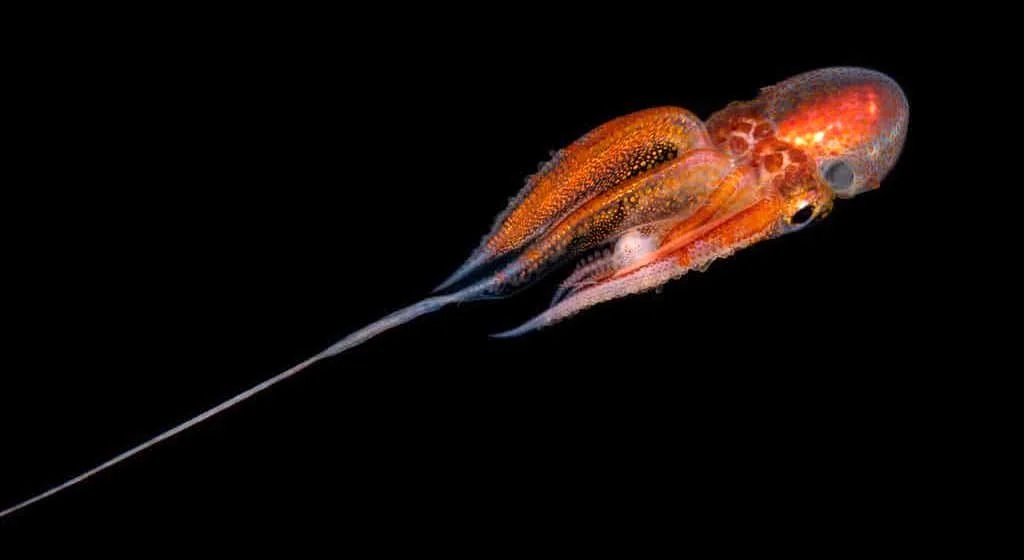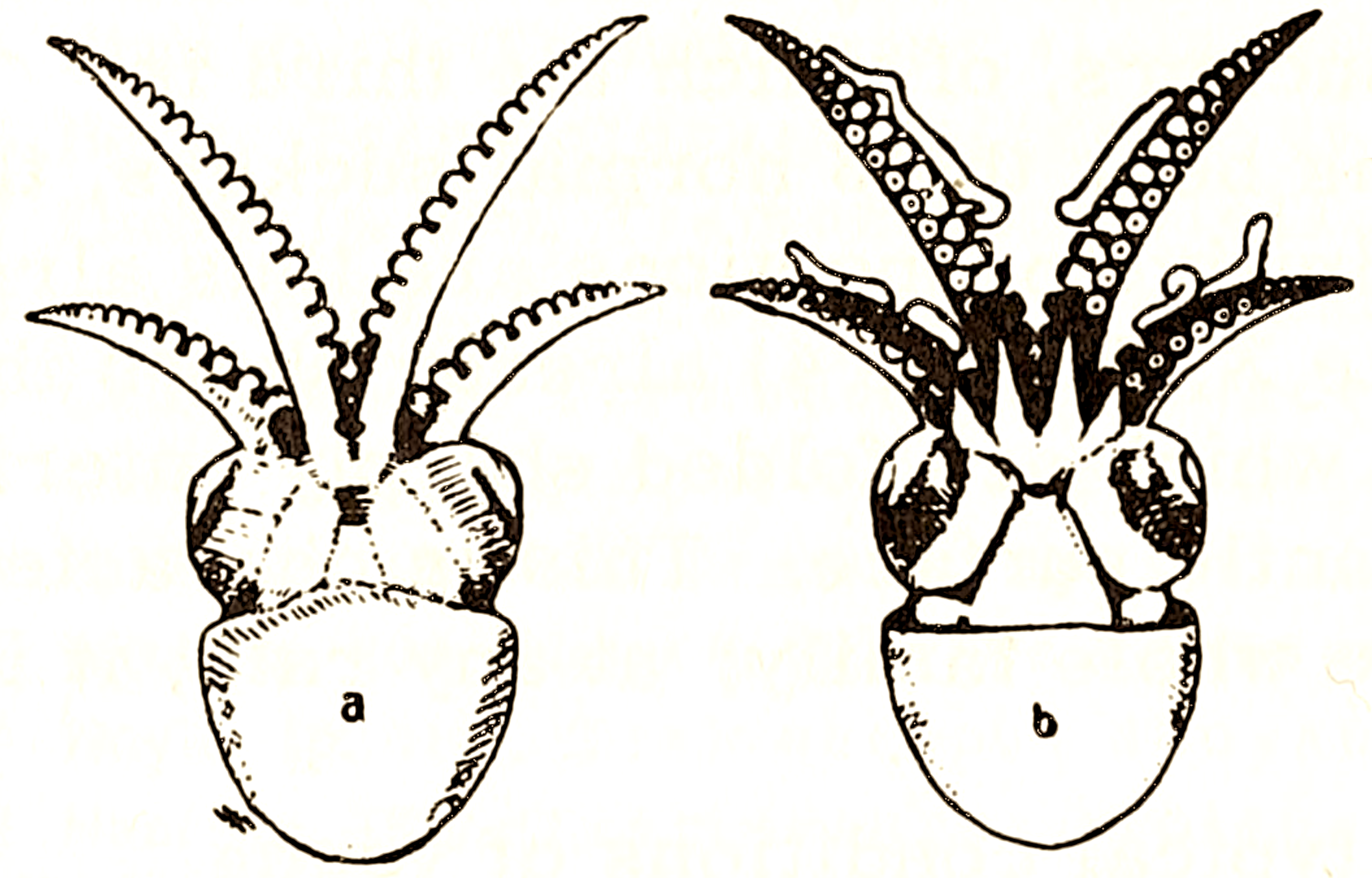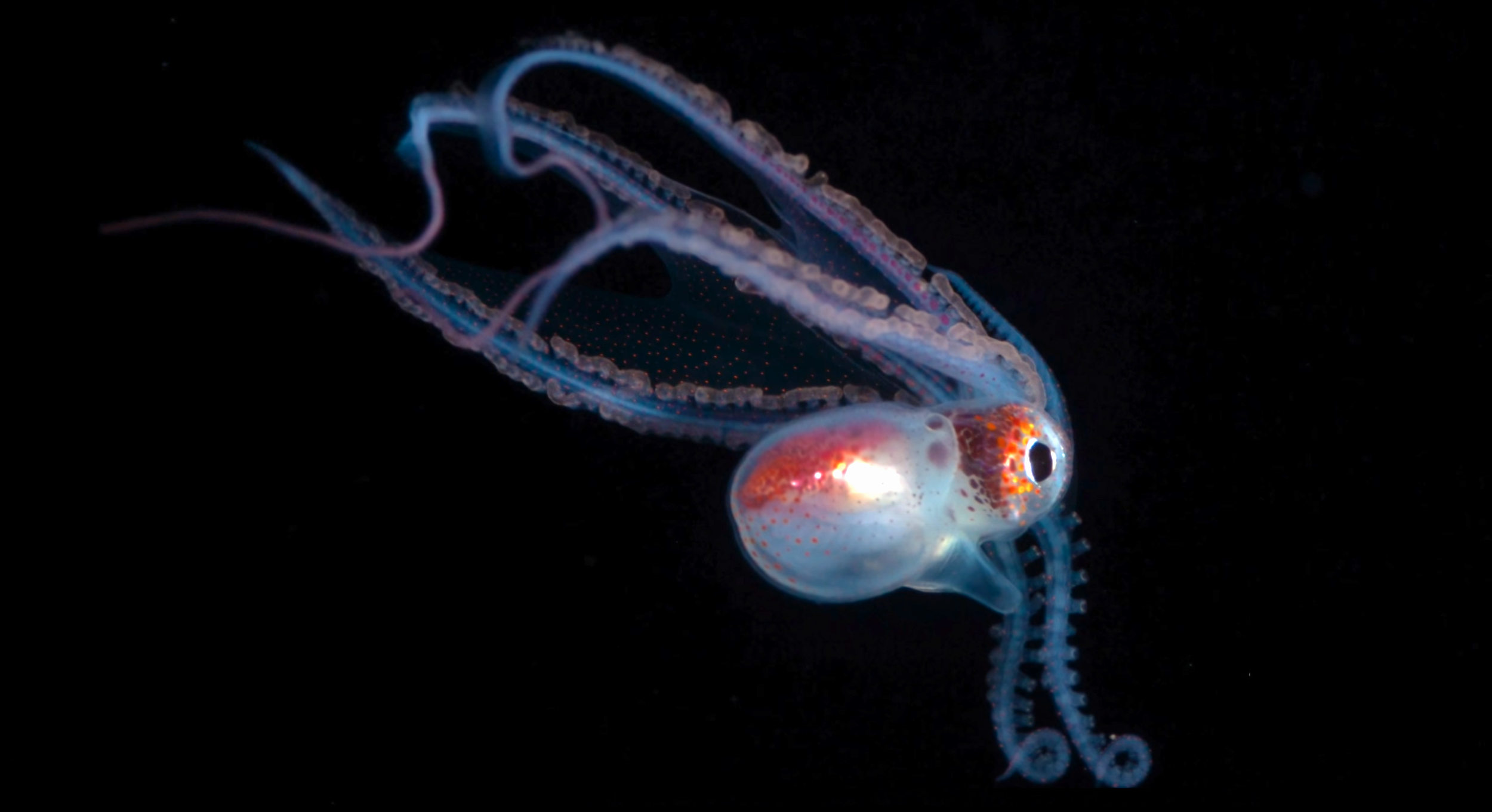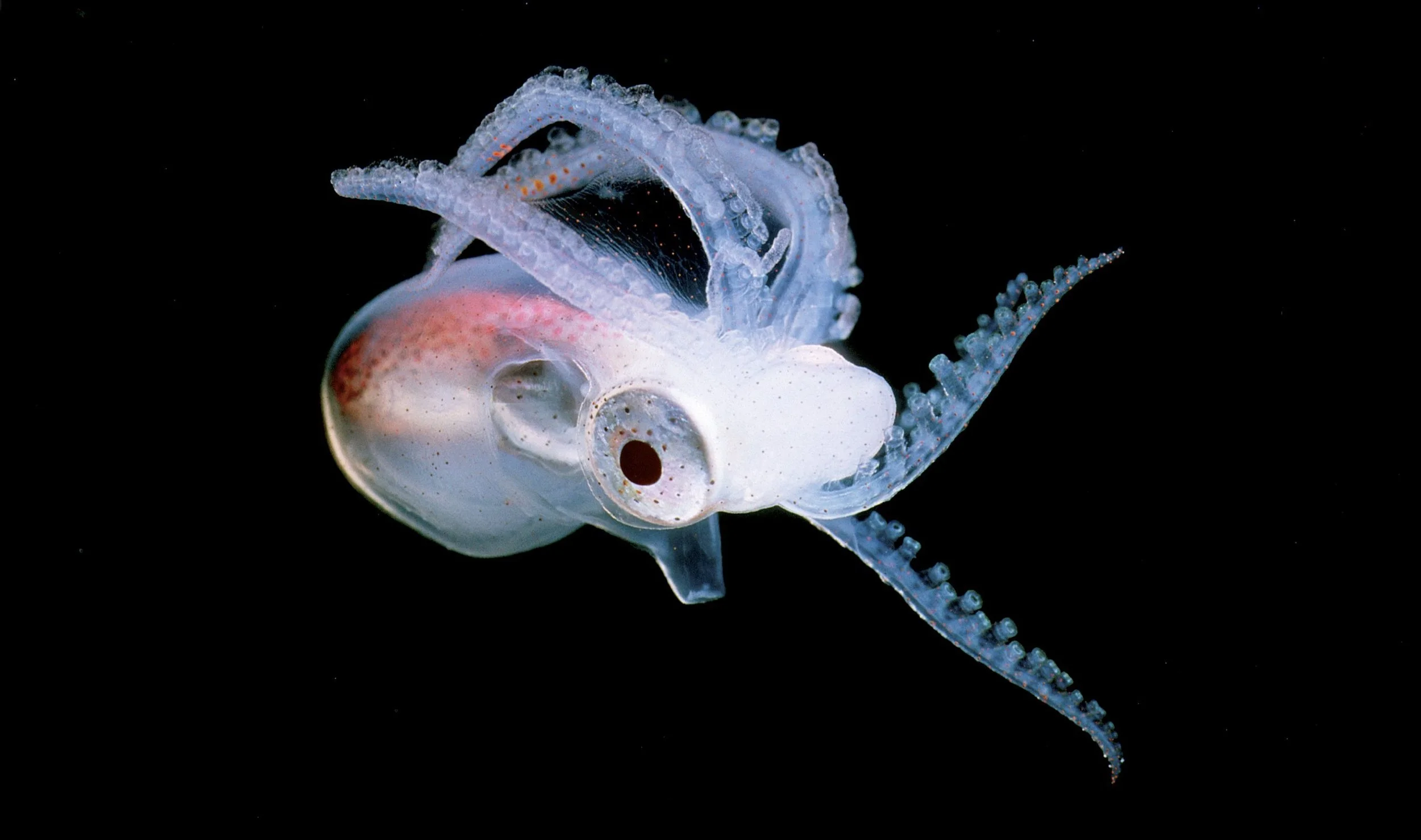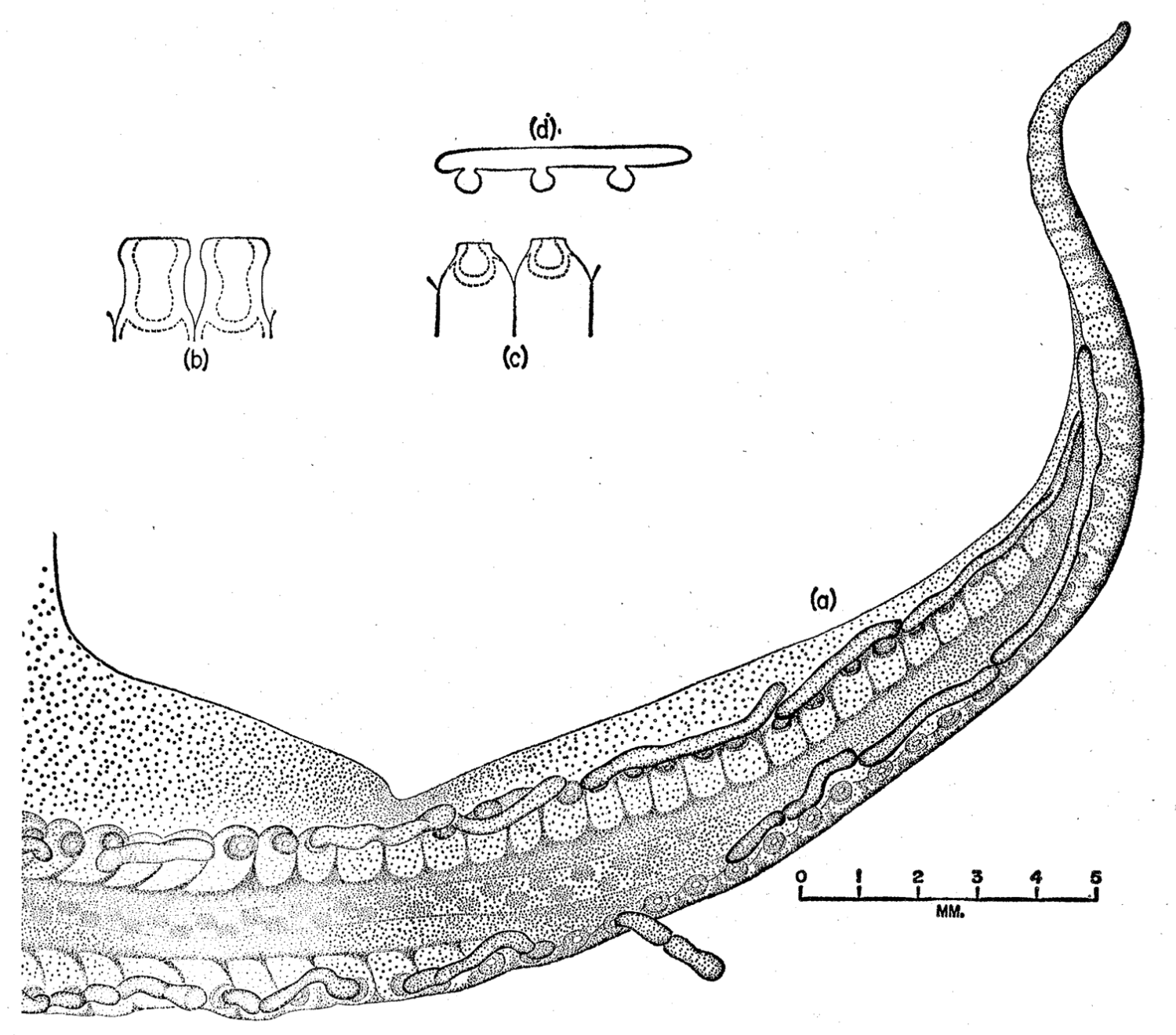1923 | Bay of Naples, Italy
Blanket octopus (Tremoctopus sp.) medusa carrying
There’s a phrase in England, to ‘grasp the nettle’. It means to take bold action on a difficult task, like forcefully grabbing a handful of the stinging nettle plant. Wild mountain gorillas are smarter than that: when they eat nettles they follow a careful series of steps that ends with a neatly folded nettle parcel, avoiding contact between the stinging barbs and the sensitive lips of the animal. When dealing with life’s irritants, boldly attacking them isn’t always the best way.
If octopuses had need of a similar phrase, it might be something like ‘grasp the medusa’. In the ocean, medusa is the name given to the free-swimming reproductive stage of the animals we commonly know as jellyfish (with allusion to the snake-haired Greek gorgon of the same name). Many jellyfish trail stinging tentacles, using them to ensnare and draw in prey. And like the mountain gorillas, some octopuses have found that there’s value to be had in careful handling of those tentacles. In the right hands/arms/suckers, the medusa is a weapon.
Getting attached
In our last post, we looked at the long history of people finding bits of squishy things attached to the claws of boxer crabs. It took some time before anyone recognised that the crabs were in fact deliberately picking up and manipulating sea anemones for their own use. So we should not be surprised when something similar happened to Adolf Naef as he tried to disentangle the relationships of the cephalopods of the Bay of Naples.
Here is Naef’s illustration of a tiny, young female of the blanket octopus Tremoctopus violaceus, published in 1923. The right-hand drawing shows what looks like little worms stuck to her centimetre-long arms:
In the English translation of his accompanying description, Naef recorded that:
Sausage-shaped bodies adhere to the suckers…They are probably parts of Cnidaria, probably tentacles of a medusa. It is not certain whether they are accidentally attached after contact with a medusa or have been captured by a host to which the nematocysts are useful, but the latter seems more probable.
At this early stage of her free-living career, the female Tremoctopus needs protection. She can eventually grow to a length of around six feet or two metres, at which point she can fend off or escape from even large predators, but during her first forays into the water column she’s just small, gelatinous prey.
When Naef examined his Italian specimen, he wasn’t sure if the little ‘sausages’ on her suckers were accidentally attached, perhaps as remnants of a meal or an unfortunate floating encounter. He reasoned that it was more likely the octopus had deliberately held onto the stinging pieces: the ‘nematocysts’ he refers to are the special cells that fire a toxic and sometimes barbed thread into other animals. Also known as cnidocytes, these cells help define the Cnidaria phylum that contains jellyfish, sea anemones and their relatives.
The past century has supported Naef’s suggestion that this isn’t an accident, as underwater photography has allowed more and more discoveries of little Tremoctopus carrying similar pieces of jellyfish tentacle. Here’s a juvenile female off the coast of Hawaii, only a couple of centimetres long, from photographer Jeffrey Milikan. The dorsal arms—those held above her body—each hold numerous small segments of medusa cells:
A little help
A female blanket octopus eventually outgrows her need for using stinging tentacles as defensive tools. She goes on to develop other techniques, including the ability to deploy the large webbing that connects her arms and give the blanket octopus its common name. She can even release part of that webbing to distract over-zealous sharks and other predators.
However, the male blanket octopus never outgrows anything. He reaches at most an inch long, with his sole purpose being to produce a special insemination arm that he needs to give to a female, should he ever float across one. The size difference (or sexual dimorphism) between the fully grown female and male blanket octopus is the largest known in nature, with the female ending up perhaps 40,000x heavier than her diminutive mates.
The male Tremoctopus could really use some help from some of those stinging tools, and it turns out he knows it. Here’s a fully mature T. violaceus male—actually the first one ever photographed in the wild, from Australia’s Great Barrier Reef—in a report by Mark Norman and colleagues in 2002:
Again, it’s those raised arms that hold the pieces of medusa. But at this point you’d be right to ask exactly what evidence there is that these animals are actually using the jellyfish stings. Has anyone ever tried to touch one of these weaponised animals?
Enter Everet Jones. In the 1960s, Jones worked for the US Bureau of Commercial Fisheries in Hawaii, and in 1963 he wrote a report on his encounter with some young female T. violaceus, which were attracted to his research vessel during a night survey in the late 1950s. Like any good biologist, he offered himself as a test subject:
I dip-netted one of these from the water and lifted it by hand out of the net. I experienced sudden and severe pain and involuntarily threw the octopod back into the water. To determine the mechanism responsible for this sensation 10 or 12 small (40 to 72 mm total length) octopods were captured and I purposely placed each one on the tender areas of my hands. The severe pain occurred each time, but careful observation indicated that I was not being bitten by the octopod. The pain and the resulting swelling and inflammation, which lasted several days, resembled the stings of the coelenterate Physalia, the Portuguese man-of-war, which was quite abundant in the area.
He didn’t find any jellyfish remains in the octopus stomach, so the Physalia likely weren’t food, but under a microscope Jones did see that some nematocysts had fired and embedded their threads in the octopus suckers holding medusa tentacles. He surmised that the little cephalopods therefore might be immune to the jellyfish toxins, and that they were deliberately collecting tentacle pieces along their dorsal arms. He even suggested that these arms were adapted to have suckers of the right size to hold the medusa pieces. In a diagram accompanying his report, the ventral suckers (b) have a large flat surface that helps them adhere and grip on to things, while the dorsal suckers (c) have smaller rounded openings that can more easily draw in and hold their thin jellyfish tools (d):
Jones noted that the pieces of jellyfish didn’t look like they were forcefully torn from their former owners. That means the medusa might be voluntarily sacrificing them, in the same way that the blanket octopus herself sheds part of her cape if needed. This is known as autotomy (or ‘self-cutting’, from the same Greek root that underlies surgical terms like appendectomy or vasectomy). It may well be that both the octopus and the medusa have adapted to their shared life, the former specialised in using tools obtained from the latter with the minimum of harm to either party.
Deep comparison
If a tiny blanket octopus can so readily arm itself with useful weapons, we might expect that the behaviour extends to other cephalopod species. And that’s exactly what Henk-Jan Hoving and Steven Haddock found as they looked through videos collected by robot submarines off the Californian and Hawaiian coasts. They weren’t looking at Tremoctopus, but instead a deep-sea octopus known as Haliphron atlanticus.
These aren’t tiny creatures like the juvenile female and adult male blanket octopus. H. atlanticus can reach up to 4m long and weigh 75kg, making it a target for other diving giants such as sperm whales. Here’s what one of the animals Hoving and Haddock found in the Monterey Submarine Canyon looked like, both while swimming (left) and hanging onto a suspicious package (right):
You won’t be surprised to see that it’s a medusa clutched in the octopus’ arms, although this is more than a few tentacle pieces held aloft for defence. The giant H. atlanticus is known to eat jellyfish, and this one has eaten much of the Phacellophora camtschatica (or egg-yolk jelly) that it’s holding. Still, the stinging tentacles remain available for use, and in their 2017 report the researchers suggested that:
in addition to feeding directly on jellyfishes, Haliphron may target the stomach contents of the medusa, or even use the medusa as a tool to obtain more nutritious prey that are captured by the fringe of tentacles clasped within the octopus arms.
Whether or not this hypothesis plays out—which will take a lot more remote submersibles scanning a lot more of the largely unexplored deep ocean to confirm—the link between octopuses and stinging medusa tentacles is clear and growing.
When we add in anemone-wielding boxer crabs, and dolphins that use marine sponges as tools to forage in the sandy seabed, the ocean may well be the key environment on this planet where wild animals regularly use other animals as directly-held tools. And while it can be tricky for scientists to determine the line between food and weapon and accidental contact, especially for cryptic or tiny species, it’s a fair bet that further investigations beneath the waves will turn up more of these cases of living technology.
Further viewing
The Monterey Bay Aquarium Research Institute (MBARI) owns the deep sea rovers that captured the images of Haliphron atlanticus reported by Hoving and Haddock in 2017. This video from MBARI goes into a bit more depth on that work, including medusa eating and capture by octopuses:
Sources: Naef, A. (1923) Fauna and Flora of the Bay of Naples (Fauna e Flora del Golfo di Napoli). Monograph No. 35 Cephalapoda Pt 1, Vol. 1, F. II. (Transl. A. Mercado, 1972). || Jones, E. (1963) Tremoctopus violaceus Uses Physalia Tentacles as Weapons. Science 139:764-766. || Norman, M. et al. (2002) First encounter with a live male blanket octopus: the world's most sexually size‐dimorphic large animal. New Zealand Journal of Marine and Freshwater Research 36:733-736. || Hoving, H. & S. Haddock (2017) The giant deep-sea octopus Haliphron atlanticus forages on gelatinous fauna. Scientific Reports 7:44952.
Main image credit: Linda Ianniello; https://lindaiphotography.com || Second image credit: Naef (1923) || Third image credit: Jeffrey Milikan; http://tolweb.org/onlinecontributors/app?service=external/ViewImageData&sp=52145 || Fourth image credit: David Paul; https://collections.museumsvictoria.com.au/species/16366 || Fifth image credit: Jones (1963) || Sixth image credit: Hoving & Haddock et al. (2017) || Video credit: MBARI; https://www.youtube.com/watch?v=CzU8CUXxLsA
